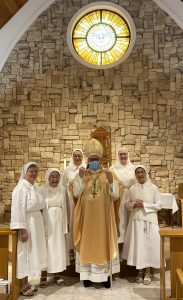Teaching the lessons of the St. Joseph, Protector of the Universal Church, has been a priority in the Catholic Schools of the Diocese of Venice for the past year.
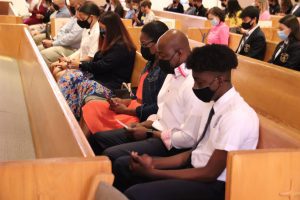 Therefore, Bishop Frank J. Dewane marked the Solemnity of St. Joseph, March 19, 2021, with a Mass in Bradenton at the Catholic school named for the Saint.
Therefore, Bishop Frank J. Dewane marked the Solemnity of St. Joseph, March 19, 2021, with a Mass in Bradenton at the Catholic school named for the Saint.
Streamed live to all Diocesan Catholic schools, the Bishop took the time to recognize the work that went into the Diocese Department of Catholic Education St. Joseph Devotional Project and the students who made the initiative a success. The concept promoted a devotion to St. Joseph, while at the same time encouraging an ongoing devotional life of both children and adults to St. Joseph.
One of the most beloved of all saints who is featured in countless works of art, Bishop Dewane reflected on how on March 19, 2020, he consecrated the Diocese of Venice to a “Year of St. Joseph” in the context of the COVID-19 Pandemic.
“I dedicated the Diocese to St. Joseph, the Protector, so that that faithful, including the students throughout the Diocese, would be safe,” the Bishop continued. “One year later we are here to give honor and Glory to God to commemorate the Solemnity of St. Joseph together.”
A model of obedience of what God asks of him, Bishop Dewane said St. Joseph freely and willingly accepted a vision he was given in life… “to be the foster father of Jesus but also the head of the Holy Family; the provider and the Protector. In this season of Lent, we must all strive to follow the example of St. Joseph and his love of Christ that he magnified so clearly.”
At the conclusion of the Mass, Bishop Dewane led the students (both in person and viewing online) in the Act of Consecration to the Most Chaste Heart of St. Joseph.
Noting that Pope Francis created a Universal “Year of St. Joseph from Dec. 8, 2020 to Dec. 8, 2021, Bishop Dewane said that like St. Joseph, “we must continue to devote ourselves to living a life that is dedicated to Jesus. Take St. Joseph as a role model going forward.”
More about the Schools St. Joseph Devotional Project
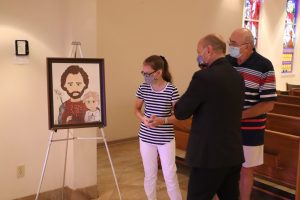 Father John Belmonte, SJ, Superintendent of Diocese Catholic Education, said the Diocesan consecration and “Year of St. Joseph” provided the ideal platform to introduce the devotion and to strengthen Catholic culture in each of the Diocesan schools.
Father John Belmonte, SJ, Superintendent of Diocese Catholic Education, said the Diocesan consecration and “Year of St. Joseph” provided the ideal platform to introduce the devotion and to strengthen Catholic culture in each of the Diocesan schools.
The foster-father of Jesus Christ is an ideal Saint to whom to have a devotion, Father Belmonte explained. St. Joseph is also guardian and protector of the Church and Her Faithful. He is a figure who led by example, while also offering powerful prayer and protection.
The goal of the St. Joseph Devotional Project was to provide age-appropriate catechesis for students so that they can carry with them a life-long devotion to St. Joseph, Father added.
Praising the effort to teach students about St. Joseph, Bishop Dewane recognized the Junior Catechists – students who served as leaders in their respective Catholic schools, sharing classroom lessons about St. Joseph and a Catholic devotion to him. Many were present for the Solemnity Mass in Bradenton and were accompanied by parents, grandparents, teachers and principals.
Each primary school selected two eighth grade Junior Catechists, a boy and a girl, to spearhead the devotion in the classroom. For the 12 weeks of the project, each week had new themes centered on the role of St. Joseph. The first week consisted of teaching about the saint and learning a Prayer to St. Joseph. Later themes included “Delight of Saints,” “Our Spiritual Father,” “Young Husband of Mary,” and more.
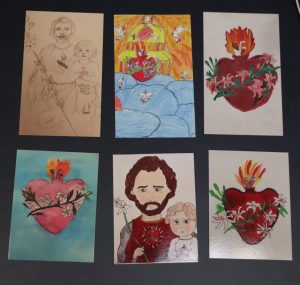 An art contest was incorporated into the St. Joseph Devotional Project, which Father Belmonte noted had more than 500 entries and ultimately six winners. The students were asked to express their idea of who St. Joseph was according to his respective titles – Protector of the Universal Church, foster father of Christ, Most Chaste Spouse of the Blessed Virgin Mary and many others.
An art contest was incorporated into the St. Joseph Devotional Project, which Father Belmonte noted had more than 500 entries and ultimately six winners. The students were asked to express their idea of who St. Joseph was according to his respective titles – Protector of the Universal Church, foster father of Christ, Most Chaste Spouse of the Blessed Virgin Mary and many others.
Veronika Bateneva, sixth grade, Epiphany Cathedral Catholic School in Venice was one of the art contest winners and brought her grandfather to the Mass. “It was such an honor to be recognized. I tried to incorporate what I know of St. Joseph into what I created.” Her artwork was of St. Joseph protectively holding the Child Jesus. St. Joseph is also holding a lily, the symbol of the Most Chaste Heart, on his chest.
The winning artists were recognized with an award and the honor of having their artwork used on prayer cards for the students of the Diocese. On the reverse of the cards is either an “Act of Consecration to the Most Chaste Heart of St. Joseph,” or a “Consecration to St. Joseph of Children by their Parents.”
Art award winners are: Ian Morales, second grade, St Catherine Catholic School, Sebring; Emmanuel Ronquillo, fourth grade, St. Joseph Catholic School, Bradenton; Emareen Ramirez, fourth grade, Epiphany Cathedral Catholic School, Venice; Veronika Bateneva, sixth grade, Epiphany Cathedral Catholic School; Eleanora Del Sole, seventh grade, Epiphany Cathedral Catholic School; and Emma Underwood, eighth grade, Epiphany Cathedral Catholic School.
Feast of St. Joseph Mass in Italian
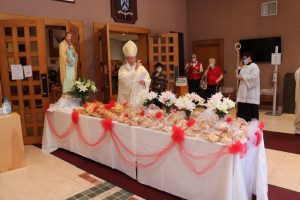 On the Solemnity of St. Joseph, Bishop Dewane also celebrated Mass at Epiphany Cathedral in Venice. The Mass was celebrated in Italian and was organized by the Italian American Club of Venice and is an annual tradition.
On the Solemnity of St. Joseph, Bishop Dewane also celebrated Mass at Epiphany Cathedral in Venice. The Mass was celebrated in Italian and was organized by the Italian American Club of Venice and is an annual tradition.
Following the conclusion of the Mass, the Bishop blessed a “St. Joseph Table,” piled with wrapped bread. The tradition of the “St. Joseph Table” of food (“la tavala di San Giuseppe”) has its origins in Sicily as part of a Middle Ages celebration of the ending of a drought where food – bread in particular – is brought to be shared among the townsfolk. The Mass was livestreamed and is available for viewing at https://vimeo.com/526325765.
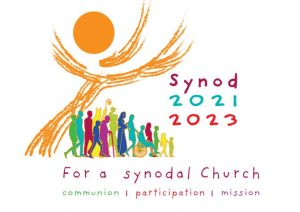 As a part of the XVI Ordinary General Assembly of the Synod of Bishops, “For a Synodal Church: Communion, Participation, and Mission,” Pope Francis has invited every Diocese in the world to inaugurate the beginning of the Synod with an opening Mass. In the Diocese of Venice, this opening Mass will be celebrated by Bishop Frank J. Dewane at 2:30 p.m., Oct. 17, 2021, at Epiphany Cathedral, 350 Tampa Ave., Venice. All are welcome and encouraged to attend this Mass. In this Diocesan Phase of the Synod, Catholics in the Diocese of Venice are encouraged to participate in listening sessions, which will be announced in the coming weeks.
As a part of the XVI Ordinary General Assembly of the Synod of Bishops, “For a Synodal Church: Communion, Participation, and Mission,” Pope Francis has invited every Diocese in the world to inaugurate the beginning of the Synod with an opening Mass. In the Diocese of Venice, this opening Mass will be celebrated by Bishop Frank J. Dewane at 2:30 p.m., Oct. 17, 2021, at Epiphany Cathedral, 350 Tampa Ave., Venice. All are welcome and encouraged to attend this Mass. In this Diocesan Phase of the Synod, Catholics in the Diocese of Venice are encouraged to participate in listening sessions, which will be announced in the coming weeks.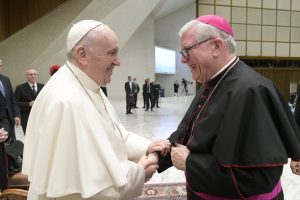

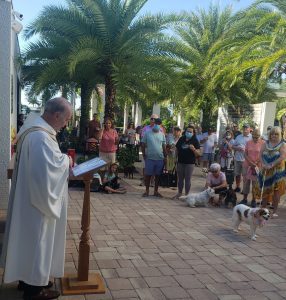
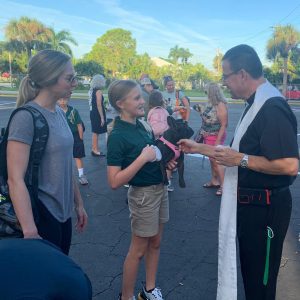






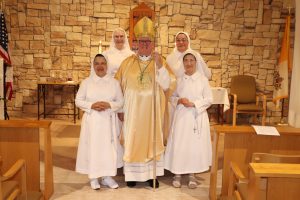 The Mass was celebrated on the Feast Day of St. Clare of Assisi, foundress of the Poor Clare Order and a contemporary of St. Francis of Assisi.
The Mass was celebrated on the Feast Day of St. Clare of Assisi, foundress of the Poor Clare Order and a contemporary of St. Francis of Assisi.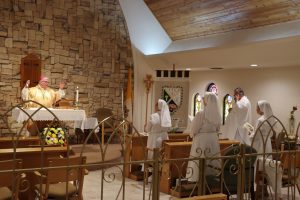 The Poor Clare Nuns are a religious community of women begun 800 years ago when Clare Offreduccio, a young noble woman of Assisi, Italy, cast off her rich garments and donned the simple garb of St. Francis to live as he did the Holy Gospel of our Lord Jesus Christ.
The Poor Clare Nuns are a religious community of women begun 800 years ago when Clare Offreduccio, a young noble woman of Assisi, Italy, cast off her rich garments and donned the simple garb of St. Francis to live as he did the Holy Gospel of our Lord Jesus Christ.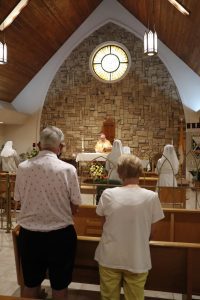 The San Damiano Monastery is located on the same property as Ascension Parish on Fort Myers Beach which that have called their home since 1988. The Monastery became independent in 2009. Although the Sisters never solicit donations, many parishioners bring them groceries and send them money each month. There is a daily Mass which is open to the public.
The San Damiano Monastery is located on the same property as Ascension Parish on Fort Myers Beach which that have called their home since 1988. The Monastery became independent in 2009. Although the Sisters never solicit donations, many parishioners bring them groceries and send them money each month. There is a daily Mass which is open to the public.
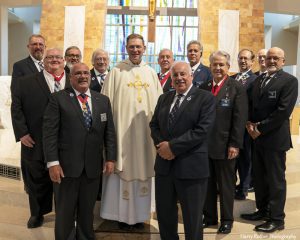
 Every day, Catholic Charities Diocese of Venice serves the most vulnerable population by feeding, housing, empowering, and striving to help those in need. This summer, you can leave your footprint by helping your neighbors. The Catholic Charities Summertime and the Giving is Easy Appeal is asking for your support. Donate to your choice of assistance, such as food, shelter, education or other support. The giving is easy! Your gift will make a positive impact on our less fortunate brothers and sisters! Please visit
Every day, Catholic Charities Diocese of Venice serves the most vulnerable population by feeding, housing, empowering, and striving to help those in need. This summer, you can leave your footprint by helping your neighbors. The Catholic Charities Summertime and the Giving is Easy Appeal is asking for your support. Donate to your choice of assistance, such as food, shelter, education or other support. The giving is easy! Your gift will make a positive impact on our less fortunate brothers and sisters! Please visit  Therefore, Bishop Frank J. Dewane marked the Solemnity of St. Joseph, March 19, 2021, with a Mass in Bradenton at the Catholic school named for the Saint.
Therefore, Bishop Frank J. Dewane marked the Solemnity of St. Joseph, March 19, 2021, with a Mass in Bradenton at the Catholic school named for the Saint. Father John Belmonte, SJ, Superintendent of Diocese Catholic Education, said the Diocesan consecration and “Year of St. Joseph” provided the ideal platform to introduce the devotion and to strengthen Catholic culture in each of the Diocesan schools.
Father John Belmonte, SJ, Superintendent of Diocese Catholic Education, said the Diocesan consecration and “Year of St. Joseph” provided the ideal platform to introduce the devotion and to strengthen Catholic culture in each of the Diocesan schools. An art contest was incorporated into the St. Joseph Devotional Project, which Father Belmonte noted had more than 500 entries and ultimately six winners. The students were asked to express their idea of who St. Joseph was according to his respective titles – Protector of the Universal Church, foster father of Christ, Most Chaste Spouse of the Blessed Virgin Mary and many others.
An art contest was incorporated into the St. Joseph Devotional Project, which Father Belmonte noted had more than 500 entries and ultimately six winners. The students were asked to express their idea of who St. Joseph was according to his respective titles – Protector of the Universal Church, foster father of Christ, Most Chaste Spouse of the Blessed Virgin Mary and many others. On the Solemnity of St. Joseph, Bishop Dewane also celebrated Mass at Epiphany Cathedral in Venice. The Mass was celebrated in Italian and was organized by the Italian American Club of Venice and is an annual tradition.
On the Solemnity of St. Joseph, Bishop Dewane also celebrated Mass at Epiphany Cathedral in Venice. The Mass was celebrated in Italian and was organized by the Italian American Club of Venice and is an annual tradition.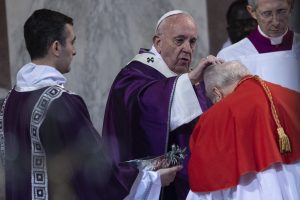 In the midst of ongoing impacts during the COVID-19 Pandemic, Pope Francis reminds us that it is “a favorable time to prepare to celebrate with renewed hearts the great mystery of the death and resurrection of Jesus, the cornerstone of our personal and communal Christian life. We must continually return to this mystery in mind and heart, for it will continue to grow within us in the measure that we are open to its spiritual power and respond with freedom and generosity.”
In the midst of ongoing impacts during the COVID-19 Pandemic, Pope Francis reminds us that it is “a favorable time to prepare to celebrate with renewed hearts the great mystery of the death and resurrection of Jesus, the cornerstone of our personal and communal Christian life. We must continually return to this mystery in mind and heart, for it will continue to grow within us in the measure that we are open to its spiritual power and respond with freedom and generosity.”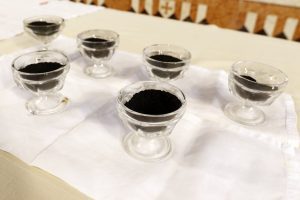 On Ash Wednesday, Feb. 17, the Congregation for Divine Worship and Discipline of the Sacraments has provided guidance on the distribution of ashes amid the Pandemic. Ashes will be sprinkled on the top of the head of the faithful, rather than applying a cross on their foreheads which necessitates contact. The formula will be said only once, at the beginning of the distribution, applying it to all in general: “Remember that you are dust, and to dust you shall return.” Following this, the guidance states that the Priest then cleanses his hands, puts on a face mask and distributes the ashes to those who come forward. The Priest takes the ashes and sprinkles them on the head of each one in silence.
On Ash Wednesday, Feb. 17, the Congregation for Divine Worship and Discipline of the Sacraments has provided guidance on the distribution of ashes amid the Pandemic. Ashes will be sprinkled on the top of the head of the faithful, rather than applying a cross on their foreheads which necessitates contact. The formula will be said only once, at the beginning of the distribution, applying it to all in general: “Remember that you are dust, and to dust you shall return.” Following this, the guidance states that the Priest then cleanses his hands, puts on a face mask and distributes the ashes to those who come forward. The Priest takes the ashes and sprinkles them on the head of each one in silence.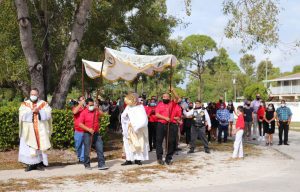 This procession took place on the Solemnity of the Epiphany of the Lord (Jan. 3, 2021), with Bishop Frank J. Dewane carrying the monstrance, and served as the opening of two days of celebrations in honor of the Feast Day of St. Elizabeth Seton on Jan. 4, 2021.
This procession took place on the Solemnity of the Epiphany of the Lord (Jan. 3, 2021), with Bishop Frank J. Dewane carrying the monstrance, and served as the opening of two days of celebrations in honor of the Feast Day of St. Elizabeth Seton on Jan. 4, 2021.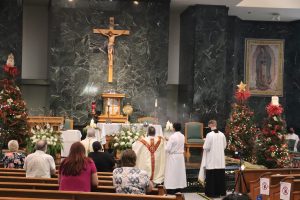 “The Lord called her through different moments of her life and despite many hardships which could have turned her attention away she didn’t forget about the call of the Lord,” the Bishop said. “Just as the three kings followed a star at the Epiphany, she followed a star and once she received the gift of Faith, it was Christ and the Lord who brought her through the stages in her life to ever more profoundly encounter Him. As St. Elizabeth Seton did, we must open ourselves up to be accessible for an encounter with the Lord.”
“The Lord called her through different moments of her life and despite many hardships which could have turned her attention away she didn’t forget about the call of the Lord,” the Bishop said. “Just as the three kings followed a star at the Epiphany, she followed a star and once she received the gift of Faith, it was Christ and the Lord who brought her through the stages in her life to ever more profoundly encounter Him. As St. Elizabeth Seton did, we must open ourselves up to be accessible for an encounter with the Lord.” St. Elizabeth Seton was born before the American Revolution and grew up in New York as part of a prominent Episcopalian family. She married in 1794 and had five children. Discovering Catholicism while in Italy, where her husband died, she eventually returned to the U.S. and entered the Catholic Church in 1805. Later, she moved to Emmitsburg, Maryland, where she entered religious life and founded the Sisters of Charity of St. Joseph, the first community for religious women established in the U.S. She also began the first free Catholic girl’s school in the country, which formed the foundation for the modern Catholic education system. She died in 1821 and was canonized on Sept. 14, 1975.
St. Elizabeth Seton was born before the American Revolution and grew up in New York as part of a prominent Episcopalian family. She married in 1794 and had five children. Discovering Catholicism while in Italy, where her husband died, she eventually returned to the U.S. and entered the Catholic Church in 1805. Later, she moved to Emmitsburg, Maryland, where she entered religious life and founded the Sisters of Charity of St. Joseph, the first community for religious women established in the U.S. She also began the first free Catholic girl’s school in the country, which formed the foundation for the modern Catholic education system. She died in 1821 and was canonized on Sept. 14, 1975.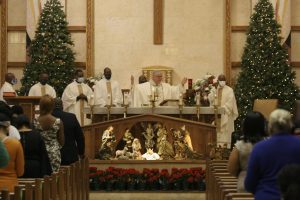 “This Mass is a big thing for me,” said the Immokalee resident who traveled to Bonita Springs to celebrate Mass with fellow emigrees of the Caribbean nation. “I took off work six months ago to be able to attend this. I cannot miss this Mass.”
“This Mass is a big thing for me,” said the Immokalee resident who traveled to Bonita Springs to celebrate Mass with fellow emigrees of the Caribbean nation. “I took off work six months ago to be able to attend this. I cannot miss this Mass.”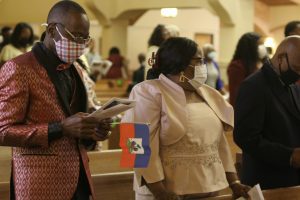 But precautions against the coronavirus meant a visiting prelate could not travel and buses could not be used to bring in Haitians from cities throughout the 10-county diocese. Yet, Father Jean-Marie Fritz Ligonde, director of Haitian Ministry for the Diocese of Venice and parochial vicar of St. Columbkille Parish in Fort Myers, said the community was blessed to still have the opportunity to celebrate the special day. As he does every year, Bishop Frank J. Dewane celebrated the Mass with Father Ligonde, and five other Haitian priests of the diocese. The precautions might have made the crowd gathered much smaller, but the spirit of the Mass was just as joyous and enthusiastic.
But precautions against the coronavirus meant a visiting prelate could not travel and buses could not be used to bring in Haitians from cities throughout the 10-county diocese. Yet, Father Jean-Marie Fritz Ligonde, director of Haitian Ministry for the Diocese of Venice and parochial vicar of St. Columbkille Parish in Fort Myers, said the community was blessed to still have the opportunity to celebrate the special day. As he does every year, Bishop Frank J. Dewane celebrated the Mass with Father Ligonde, and five other Haitian priests of the diocese. The precautions might have made the crowd gathered much smaller, but the spirit of the Mass was just as joyous and enthusiastic.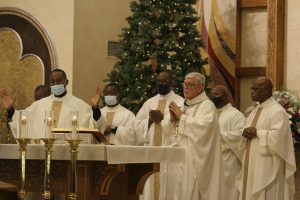 In his homily, Father Ligonde compared the Marian feast celebrated to Haiti’s Independence Day. The Solemnity of Mary, mother of God, is the first Marian feast, and Haiti is the first independent Black nation in the Western Hemisphere when the slaves there gained independence from France Jan. 1, 1804. Haitians should find strength in Mary’s example to go forward because Mary, even she suffered and exiled while carrying Jesus.
In his homily, Father Ligonde compared the Marian feast celebrated to Haiti’s Independence Day. The Solemnity of Mary, mother of God, is the first Marian feast, and Haiti is the first independent Black nation in the Western Hemisphere when the slaves there gained independence from France Jan. 1, 1804. Haitians should find strength in Mary’s example to go forward because Mary, even she suffered and exiled while carrying Jesus.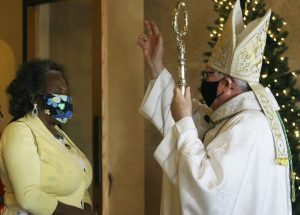 The Mass ended with the congregation waving Haitian flags and singing their country’s national anthem — “La Dessalinienne,” named in honor of Haiti’s revolutionary leader and first ruler Jean-Jacques Dessalines. It begins, “For the country, For the ancestors, Let us march. Let us march united.”
The Mass ended with the congregation waving Haitian flags and singing their country’s national anthem — “La Dessalinienne,” named in honor of Haiti’s revolutionary leader and first ruler Jean-Jacques Dessalines. It begins, “For the country, For the ancestors, Let us march. Let us march united.” Warring lost her husband of 58 years in 2016 when Sammy was nearly 3 years old and the two have been nearly inseparable since. The companionship has been valued more since the pandemic began, which is why Warring wanted to be certain Sammy received a proper blessing with Holy Water from Deacon Jack Milholland.
Warring lost her husband of 58 years in 2016 when Sammy was nearly 3 years old and the two have been nearly inseparable since. The companionship has been valued more since the pandemic began, which is why Warring wanted to be certain Sammy received a proper blessing with Holy Water from Deacon Jack Milholland.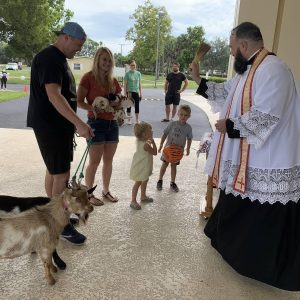
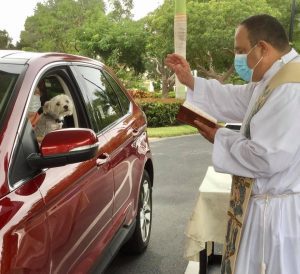
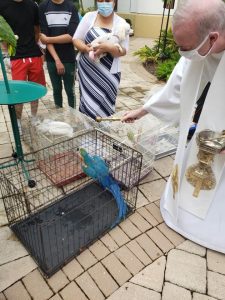
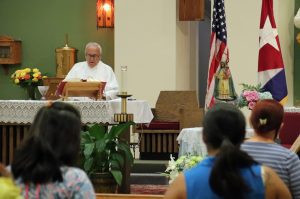 St. Jude Pastor, Father Celestino Gutierrez, said the celebration of the Patroness of Cuba was toned-down this year because of the COVID-19 Pandemic. However, the faith of the people was not diminished.
St. Jude Pastor, Father Celestino Gutierrez, said the celebration of the Patroness of Cuba was toned-down this year because of the COVID-19 Pandemic. However, the faith of the people was not diminished.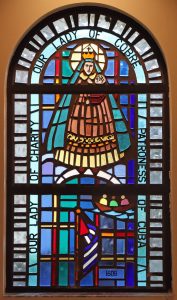 Diaz prayed for “protection and comfort,” during these turbulent times of pandemic and economic difficulties. “It’s what my family used to pray for before they left Cuba many years ago, and what we still all pray for. Our Lady is always there for us.”
Diaz prayed for “protection and comfort,” during these turbulent times of pandemic and economic difficulties. “It’s what my family used to pray for before they left Cuba many years ago, and what we still all pray for. Our Lady is always there for us.”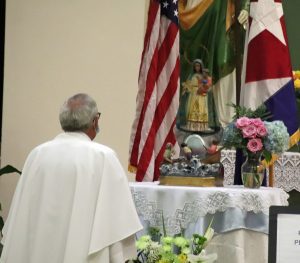 Devotion to the Mary under the title of Our Lady of Charity dates to 1612 when two indigenous laborers and a slave boy were on a boat in a fierce storm when they sought the protection of Mary. The storm suddenly calmed and then in the distance they spotted a white bundle floating on a piece of wood. It was a small statue of Mary holding the infant Jesus on her left arm and a gold cross on her raised right hand. Inscribed on the wooden board were the words, “Yo soy la Virgen de la Caridad” (“I am Our Lady of Charity”). Despite being found in the water after a storm, the white material in which the statue was wrapped in remained completely dry.
Devotion to the Mary under the title of Our Lady of Charity dates to 1612 when two indigenous laborers and a slave boy were on a boat in a fierce storm when they sought the protection of Mary. The storm suddenly calmed and then in the distance they spotted a white bundle floating on a piece of wood. It was a small statue of Mary holding the infant Jesus on her left arm and a gold cross on her raised right hand. Inscribed on the wooden board were the words, “Yo soy la Virgen de la Caridad” (“I am Our Lady of Charity”). Despite being found in the water after a storm, the white material in which the statue was wrapped in remained completely dry.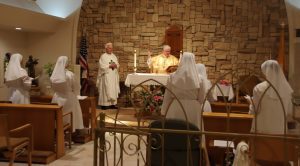 Bishop Frank J. Dewane expressed his profound gratitude to the Poor Clare Sisters for their response to God while remarking how the ongoing global pandemic has forced many into isolation, which he prays has encouraged the faithful to use that time growing closer to the Lord.
Bishop Frank J. Dewane expressed his profound gratitude to the Poor Clare Sisters for their response to God while remarking how the ongoing global pandemic has forced many into isolation, which he prays has encouraged the faithful to use that time growing closer to the Lord.